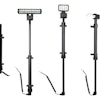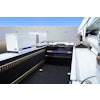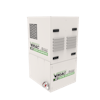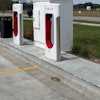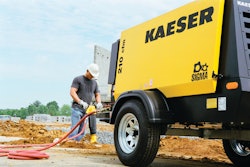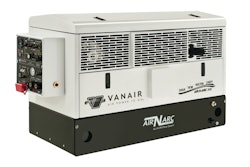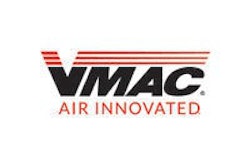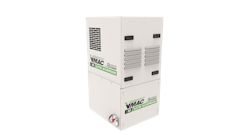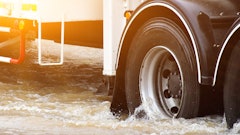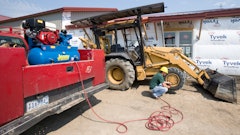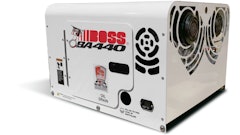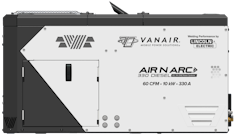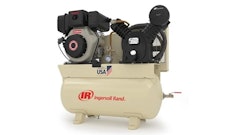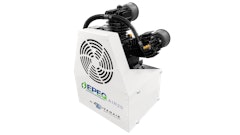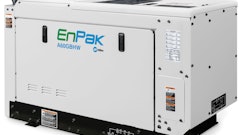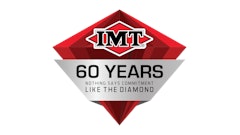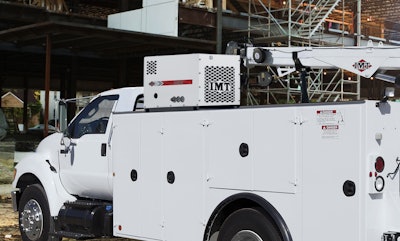
When selecting an onboard air compressor, start with the basics. Determine how much pressure (psi) and flow (cfm) is required, then determine the duty cycle.
“Ask yourself what you will be doing with the compressor and then make sure you will not be overworking it,” advises Tim Worman, business development manager at IMT. “For example, if you run a 1-in. impact wrench 80% of the time, you would overwork a 35-cfm compressor. You would cycle the compressor more often and waste time while the air tank is refilling.” A compressor with a higher cfm rating would be more appropriate.
Evaluate tools used on a regular basis to determine power requirements. “The tools that you use most often need to operate with maximum efficiency and no downtime,” says Mike Pettigrew, marketing manager, VMAC. Consider air tool specifications as well as maintenance. “If air tools are improperly serviced, they require more air power to do the same job as a properly serviced air tool.”
Air flow is obviously the No. 1 requirement. “If you use multiple tools simultaneously, add their cfm together to be able to operate both at the same time,” says Jim Perschke, VP of Global Sales, Vanair Mfg. Most tools require 90 or 100 psi, though some may require 150 to 200 psi.
Once you determine the flow and pressure requirements, make sure the truck and/or PTO can handle the load. More horsepower is required for higher flows and pressures.
Drive Considerations
Power requirements also help determine the best compressor drive option. “In the 100- to 200-cfm range, the up-front cost of engine driven is significantly more than a PTO-driven compressor,” says Perschke. “In the 20- to 90-cfm range, the decision is really made by how the truck is equipped. Does the truck already utilize hydraulics or is it equipped with a PTO port for a hydraulic system? If the answer is no, then an engine-driven compressor is the right answer.”
“The most effective way to drive a compressor is largely dependent on the application,” says Worman. “While in the past, direct PTO drives were most common — partially because other options led to significant power inefficiencies — engineering improvements to these alternatives have increased the number of compressor drive options. If the machine already has a hydraulic system, a hydraulic compressor drive might be a simple solution.” If not, owners are increasingly choosing a gas or diesel engine rather than the truck’s main engine as the primary drive.
High-demand air applications still favor a PTO drive. “A simple rule of thumb: if the application requires more than 25 hp, the under-deck PTO drive is the right choice,” says Perschke.
Below-deck, PTO compressors are an alternative to a tow-behind. They are typically rotary screw designs capable of delivering 90 to 220 cfm of air. “If you used a tow-behind or skid-mounted compressor to perform your job in the past, then you would require more than 25 hp and would need a PTO-driven system,” says Perschke. “Under-deck air compressors will operate large pneumatic tools like jackhammers, rock drills and underground boring equipment.”
However, be careful to avoid common mistakes when selecting an under-body compressor. A common issue is not understanding what continuous-duty torque limitations exist, or how the truck needs to be ordered so that the under-body unit will fit properly. “Fuel tanks, exhaust, brakes, cab-to-axle, wheelbase and cab type all have an impact on the integration process,” says Perschke. Other issues include potential relocation of DEF tanks or 4x4 transfer cases.
Trucks can be factory equipped with connections to the engine and transmission control modules to improve the quality of compressor installation.
Engine-driven above-deck compressors save wear and tear on the truck’s engine and transmission. “Engine-driven, above-deck air compressors are often self-contained units, as they may have their own battery, fuel tank and air reservoir,” says Al Kuhlman, assistant product manager, Stellar Industries. Installation is simple: they can be bolted to the truck bed, have an airline run to the air filter/regulator and they’re ready to use.
Diesel and gas options are commonly available. “Diesel engines are significantly more expensive,” says Perschke. “It might make sense to choose one over the other if the operator plans to use chassis fuel rather than having to constantly fill the compressor’s fuel tank.”
Reciprocating vs. Rotary Screw
While other types of air compressors exist, the dominant configurations are rotary screw and reciprocating.
Reciprocating compressors come in single-and two-stage variants. The single-stage version uses one piston stroke to compress the air, and the two-stage compressor has two separate compression strokes. The first compression stroke partially compresses the air, then sends it to a second compression stroke to complete compression. The key difference is that the two-stage compressor will have an easier time keeping up with constant demand, such as that created by an impact wrench.
The single-stage compressor can save up-front cost in less demanding applications. They generally offer pressures from 70 to 100 psi, while two-stage compressors are often used for higher pressures from 100 to 250 psi.
Rotary screw compressors typically utilize two precise meshing rotary screws to compress the air between them. They can provide high volumes of high-pressure air at a continuous duty cycle for high-power air tools, such as jackhammers. In addition, they are a relatively simple design with no valves. They provide instant air on demand but do require very high rotor speeds.
“Rotary screw compressors and reciprocating piston compressors each have unique benefits, and IMT offers both types to provide our customers with the best option to meet their specific needs,” says Worman. “Today’s larger equipment is creating a greater demand for air to get the job done. So when an operator needs a continuous supply of air on demand, it makes sense to invest in rotary screw compressors. These units are designed to run for extended periods of time.”
Although rotary screw compressors don’t require a reservoir tank, IMT recommends utilizing a tank to help dissipate heat and remove moisture from the air. “In addition, a reservoir tank provides operators with a quick burst of air without the need to power up the compressor,” says Worman.
Rotary screw compressors are not necessary for short, intermittent air needs. “For those applications, a reciprocating piston compressor is likely the best option,” says Worman. “If you are not operating anything more than a 1/4-in. impact wrench, you are probably just fine with a reciprocating compressor. Be realistic about your use, and don’t buy purely on price.”
Each compressor type has unique characteristics. “Rotary screw compressors generally produce more cfm output for their footprint, but a two-stage reciprocating compressor can produce higher pressures,” says Kuhlman. “Since reciprocating compressors have more moving parts, they tend to be heavier than rotary screw compressors and take up more space.”
Also consider return on investment. “When up-front cost is the primary driver, the reciprocating air compressor is the cheaper solution,” Pettigrew points out. “When jobsite performance and job cost are the primary drivers, then the rotary screw will provide a better long-term return on investment.”
But there will be trade-offs with any choice. “The size of the compressor and the materials used in its manufacture will all impact weight, performance, maintenance and life expectancy,” says Perschke. “It is very difficult to get everything. For example, a cast iron reciprocating compressor might be heavier than an aluminum design; however, the cast iron design will last longer. A reciprocating compressor requires an air storage tank, whereas rotary screw compressors do not.”
Choose the Best Placement
Above-deck compressors are the most popular for mechanic’s trucks since there is already room on the side pack.
“Under-body air compressors are used when a lot of air is required and the customer has the ability to run two PTO units or only needs an air compressor and does not run other PTO-driven equipment,” says Kuhlman.
“Under-hood air compressors are another viable option when there are space constraints either on the truck’s transmission or in the truck’s bed,” he continues. “Under-hood air compressors are a great option when using a van body as a work truck platform, since there is very little vehicle work area taken.”
Consider both the vehicle and your specific requirements for a compressor when deciding upon placement. “To determine whether an under-hood, under-body or above-deck air compressor is most appropriate for my application, I need to consider the design of my truck body, including space and weight limitations,” says Pettigrew. “The amount of air I require for my tools or application is critical at this point, as this may reduce the number of available options. I also need to determine which power source I have available on the truck, including PTO and/or hydraulics. Lastly, I need to understand my applications, and what other equipment may be needed on the jobsite, such as a crane, welder, generator or booster.”
Avoid Common Mistakes
Make sure you understand compressor duty cycle. “One of the most common mistakes is choosing an air compressor that requires a 100% duty cycle in an application that would require one with less,” says Kuhlman.
“One example would be choosing a rotary screw compressor and operating it periodically. Rotary screw compressors work best when allowed to get to their operating temp and run there for a period of time greater than 15 minutes,” he explains. “This allows the moisture to evaporate out of the oil in the compressor, saving on maintenance requirements. In this instance, a reciprocating compressor would be best.”
Avoid under sizing to save up-front cost. “You may go with a smaller cfm air compressor to save money up front, but your application requires more air flow than what the compressor can efficiently produce,” says Kuhlman. “This leads to increased duty cycles and premature wear on compressor components, and ultimately replacing the compressor.”
Also avoid purchasing simply based on past history. Advancements in air compressor technology have given customers many new options. Research all options and technology advancements.
“Air compressors are one of the most important pieces of equipment on the jobsite and deserve the necessary attention to ensure the best solution is specified for the application,” says Pettigrew.
Invest the time to understand both the application and work environment. “This includes speaking with operators on the jobsite and learning about their challenges, and how they truly use the truck and air compressor,” says Pettigrew.
“An example of how purchasing may make a mistake is if they specify an air compressor that has its own engine power so that the truck engine does not have to idle. This is a great idea on the surface,” he notes, “but in reality, the operator may continue to idle the truck engine because they need to keep the cab heated in the winter and cooled in the summer.”
